A Case Study on the Closure of Holden-General Motors (Australia)
VerifiedAdded on 2023/04/06
|13
|2035
|55
Case Study
AI Summary
This case study critically examines the closure of Holden-General Motors (GMH) in Australia, exploring the reasons cited by the company such as high tariff rates and dominance of multinational competitors. It employs Porter's Five Forces model and PEST analysis to dissect the external factors influencing the decision. The study also assesses the impact of the closure on the Australian economy, particularly the automotive industry, and the adverse effects on employment and related sectors, questioning whether the shutdown could have been avoided with strategic risk management.
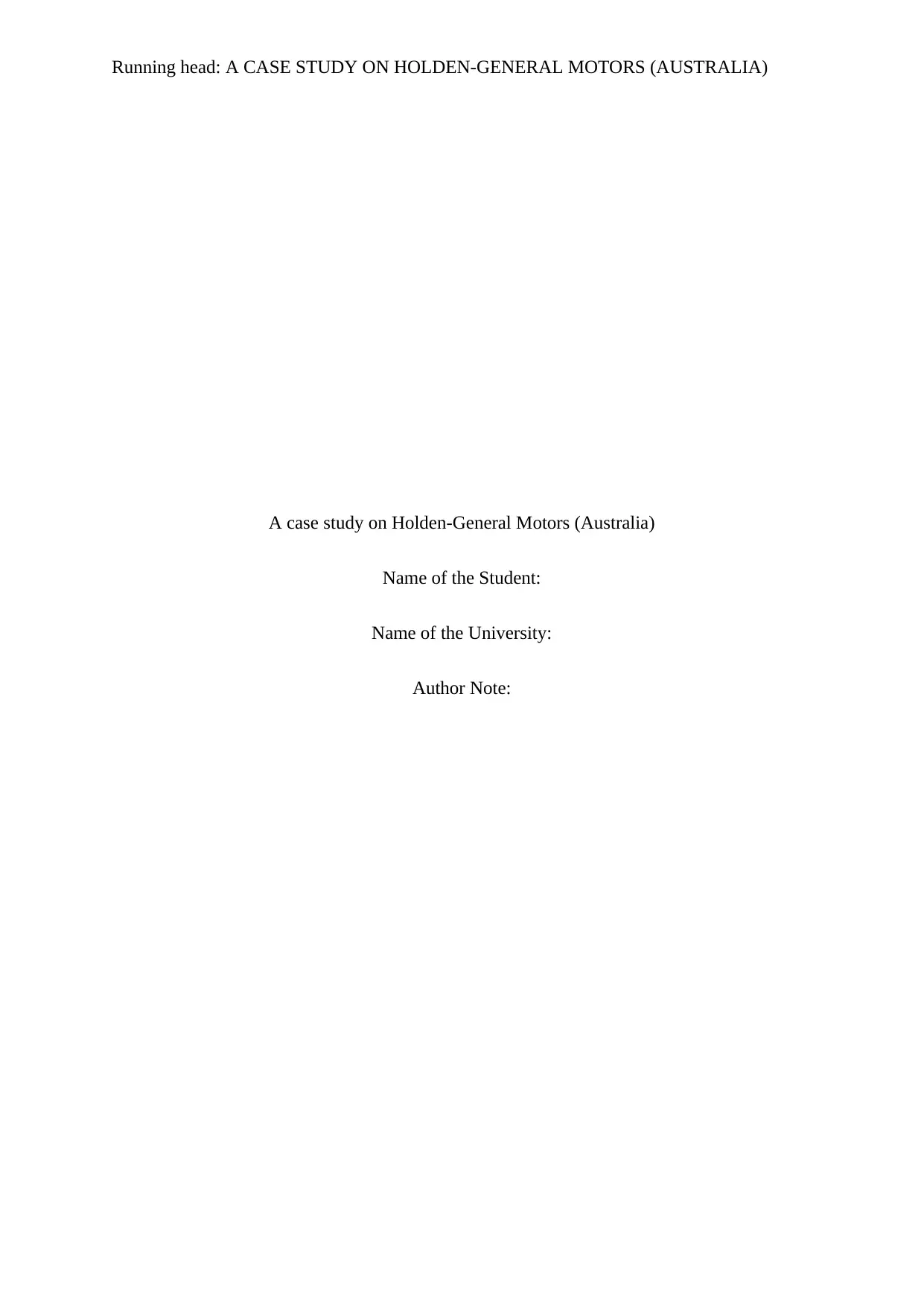
Running head: A CASE STUDY ON HOLDEN-GENERAL MOTORS (AUSTRALIA)
A case study on Holden-General Motors (Australia)
Name of the Student:
Name of the University:
Author Note:
A case study on Holden-General Motors (Australia)
Name of the Student:
Name of the University:
Author Note:
Paraphrase This Document
Need a fresh take? Get an instant paraphrase of this document with our AI Paraphraser
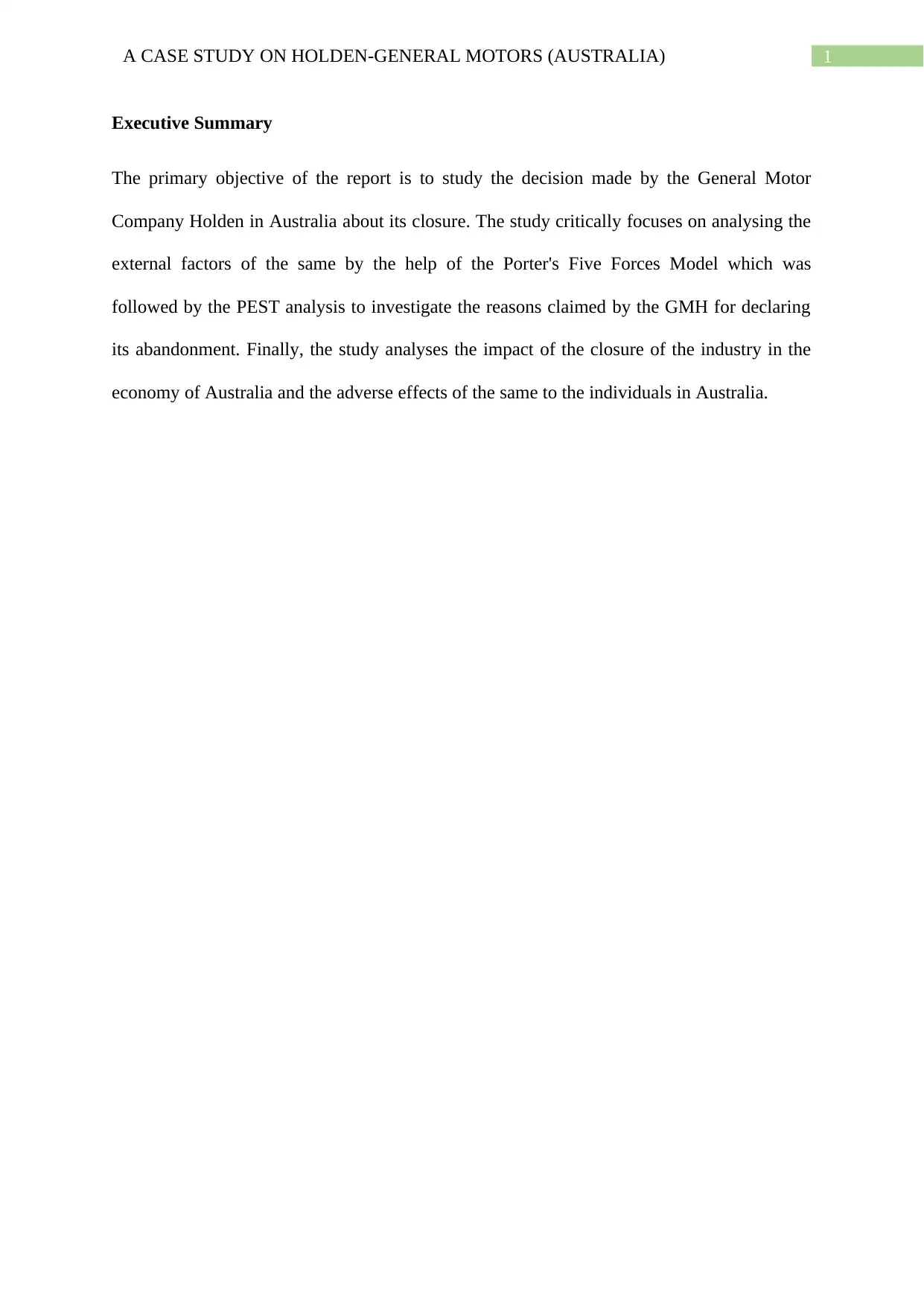
1A CASE STUDY ON HOLDEN-GENERAL MOTORS (AUSTRALIA)
Executive Summary
The primary objective of the report is to study the decision made by the General Motor
Company Holden in Australia about its closure. The study critically focuses on analysing the
external factors of the same by the help of the Porter's Five Forces Model which was
followed by the PEST analysis to investigate the reasons claimed by the GMH for declaring
its abandonment. Finally, the study analyses the impact of the closure of the industry in the
economy of Australia and the adverse effects of the same to the individuals in Australia.
Executive Summary
The primary objective of the report is to study the decision made by the General Motor
Company Holden in Australia about its closure. The study critically focuses on analysing the
external factors of the same by the help of the Porter's Five Forces Model which was
followed by the PEST analysis to investigate the reasons claimed by the GMH for declaring
its abandonment. Finally, the study analyses the impact of the closure of the industry in the
economy of Australia and the adverse effects of the same to the individuals in Australia.
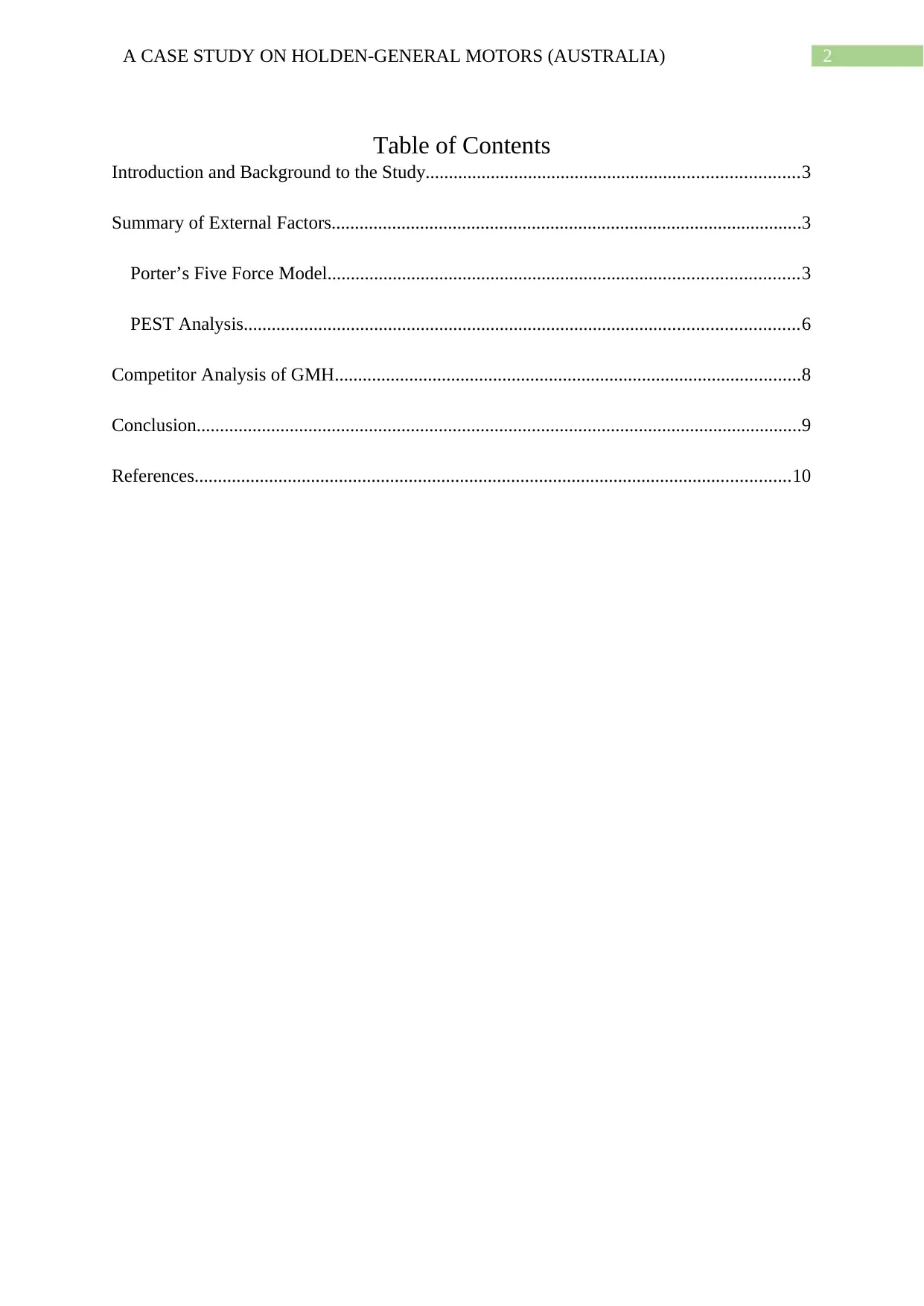
2A CASE STUDY ON HOLDEN-GENERAL MOTORS (AUSTRALIA)
Table of Contents
Introduction and Background to the Study................................................................................3
Summary of External Factors.....................................................................................................3
Porter’s Five Force Model.....................................................................................................3
PEST Analysis.......................................................................................................................6
Competitor Analysis of GMH....................................................................................................8
Conclusion..................................................................................................................................9
References................................................................................................................................10
Table of Contents
Introduction and Background to the Study................................................................................3
Summary of External Factors.....................................................................................................3
Porter’s Five Force Model.....................................................................................................3
PEST Analysis.......................................................................................................................6
Competitor Analysis of GMH....................................................................................................8
Conclusion..................................................................................................................................9
References................................................................................................................................10
⊘ This is a preview!⊘
Do you want full access?
Subscribe today to unlock all pages.

Trusted by 1+ million students worldwide

3A CASE STUDY ON HOLDEN-GENERAL MOTORS (AUSTRALIA)
Introduction and Background to the Study
The study critically examines the closure of the Holden Co. in Australia (Barbaro and
Spoehr 2014). This closure was given a reason for high tariff rate prevailing in Australia
which was estimated to be only 0.89% in 2017. This was considerably less as compared to
the prevailing rates since 2010 to be 2.89%. In this connection, the study claims that the
closure of the company would have been avoided. Another broad reason given was the
dominance of other big multi-national companies, which could be considered valid to some
extent in the connection that the price rates difference resulted in shifting of customers to
other companies and the potential competitors effectively satisfied the needs of the
customers. This evidence and the additional analysis in the study explains the closure of the
GMH (Arrowsmith and Zangalis 1965).
Summary of External Factors
A business firm’s system of sustaining themselves for a long-term basis is affected by
some external factors of the environment (Nayeem and Casidy 2013). It helps them in
retaining both their employees and customers. In this context, the following sections of the
paper will discuss those important external factors in the context of the General Motor
Industry Holden.
Porter’s Five Force Model
The model is named after Michael E Porter (David 2013). It is a strategical analysing
tool which helps to understand the critical factors affecting the market conditions and the
level of competition. The five forces according to The GMH can be determined as below
(Hammond 2013):
Introduction and Background to the Study
The study critically examines the closure of the Holden Co. in Australia (Barbaro and
Spoehr 2014). This closure was given a reason for high tariff rate prevailing in Australia
which was estimated to be only 0.89% in 2017. This was considerably less as compared to
the prevailing rates since 2010 to be 2.89%. In this connection, the study claims that the
closure of the company would have been avoided. Another broad reason given was the
dominance of other big multi-national companies, which could be considered valid to some
extent in the connection that the price rates difference resulted in shifting of customers to
other companies and the potential competitors effectively satisfied the needs of the
customers. This evidence and the additional analysis in the study explains the closure of the
GMH (Arrowsmith and Zangalis 1965).
Summary of External Factors
A business firm’s system of sustaining themselves for a long-term basis is affected by
some external factors of the environment (Nayeem and Casidy 2013). It helps them in
retaining both their employees and customers. In this context, the following sections of the
paper will discuss those important external factors in the context of the General Motor
Industry Holden.
Porter’s Five Force Model
The model is named after Michael E Porter (David 2013). It is a strategical analysing
tool which helps to understand the critical factors affecting the market conditions and the
level of competition. The five forces according to The GMH can be determined as below
(Hammond 2013):
Paraphrase This Document
Need a fresh take? Get an instant paraphrase of this document with our AI Paraphraser
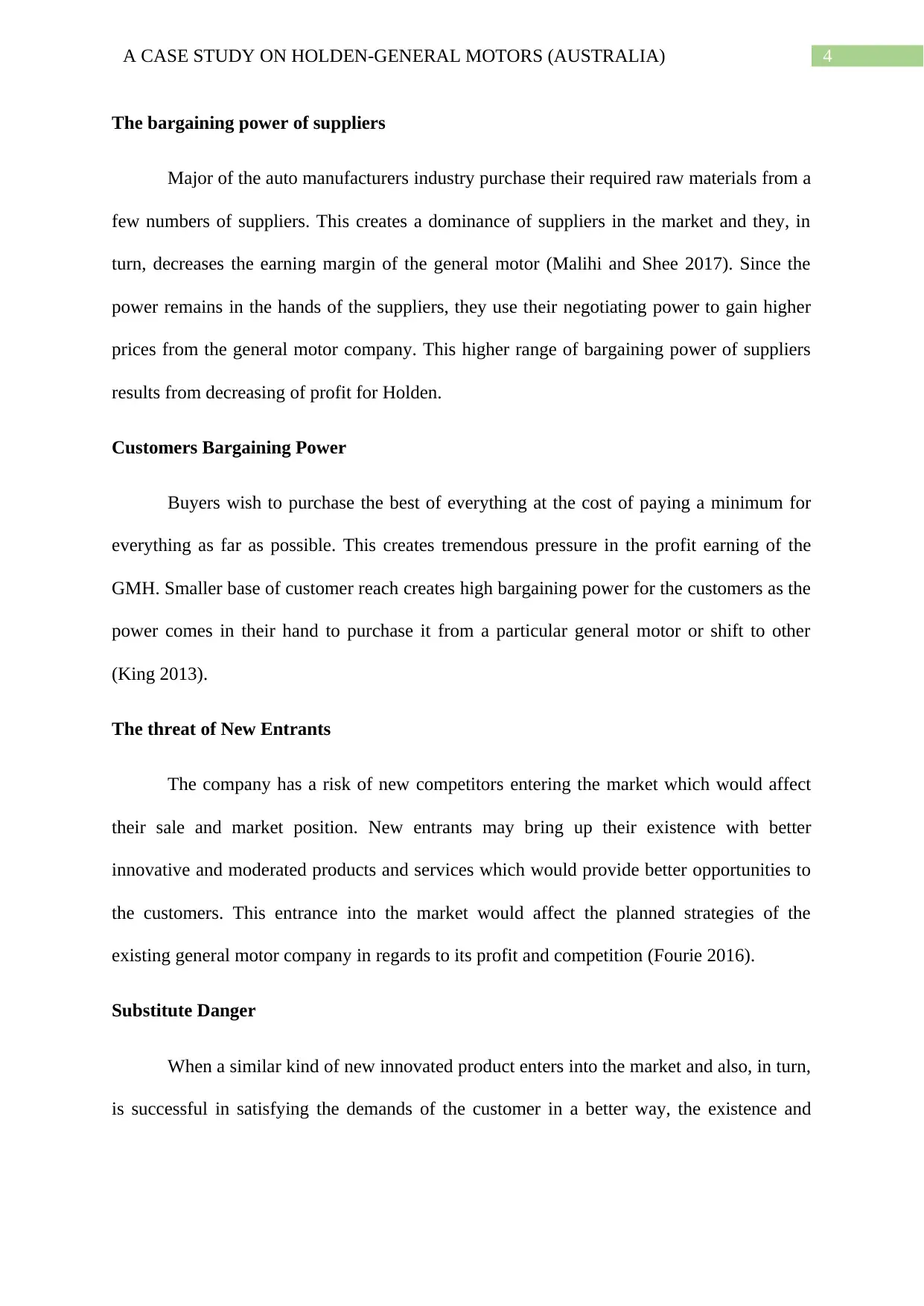
4A CASE STUDY ON HOLDEN-GENERAL MOTORS (AUSTRALIA)
The bargaining power of suppliers
Major of the auto manufacturers industry purchase their required raw materials from a
few numbers of suppliers. This creates a dominance of suppliers in the market and they, in
turn, decreases the earning margin of the general motor (Malihi and Shee 2017). Since the
power remains in the hands of the suppliers, they use their negotiating power to gain higher
prices from the general motor company. This higher range of bargaining power of suppliers
results from decreasing of profit for Holden.
Customers Bargaining Power
Buyers wish to purchase the best of everything at the cost of paying a minimum for
everything as far as possible. This creates tremendous pressure in the profit earning of the
GMH. Smaller base of customer reach creates high bargaining power for the customers as the
power comes in their hand to purchase it from a particular general motor or shift to other
(King 2013).
The threat of New Entrants
The company has a risk of new competitors entering the market which would affect
their sale and market position. New entrants may bring up their existence with better
innovative and moderated products and services which would provide better opportunities to
the customers. This entrance into the market would affect the planned strategies of the
existing general motor company in regards to its profit and competition (Fourie 2016).
Substitute Danger
When a similar kind of new innovated product enters into the market and also, in turn,
is successful in satisfying the demands of the customer in a better way, the existence and
The bargaining power of suppliers
Major of the auto manufacturers industry purchase their required raw materials from a
few numbers of suppliers. This creates a dominance of suppliers in the market and they, in
turn, decreases the earning margin of the general motor (Malihi and Shee 2017). Since the
power remains in the hands of the suppliers, they use their negotiating power to gain higher
prices from the general motor company. This higher range of bargaining power of suppliers
results from decreasing of profit for Holden.
Customers Bargaining Power
Buyers wish to purchase the best of everything at the cost of paying a minimum for
everything as far as possible. This creates tremendous pressure in the profit earning of the
GMH. Smaller base of customer reach creates high bargaining power for the customers as the
power comes in their hand to purchase it from a particular general motor or shift to other
(King 2013).
The threat of New Entrants
The company has a risk of new competitors entering the market which would affect
their sale and market position. New entrants may bring up their existence with better
innovative and moderated products and services which would provide better opportunities to
the customers. This entrance into the market would affect the planned strategies of the
existing general motor company in regards to its profit and competition (Fourie 2016).
Substitute Danger
When a similar kind of new innovated product enters into the market and also, in turn,
is successful in satisfying the demands of the customer in a better way, the existence and
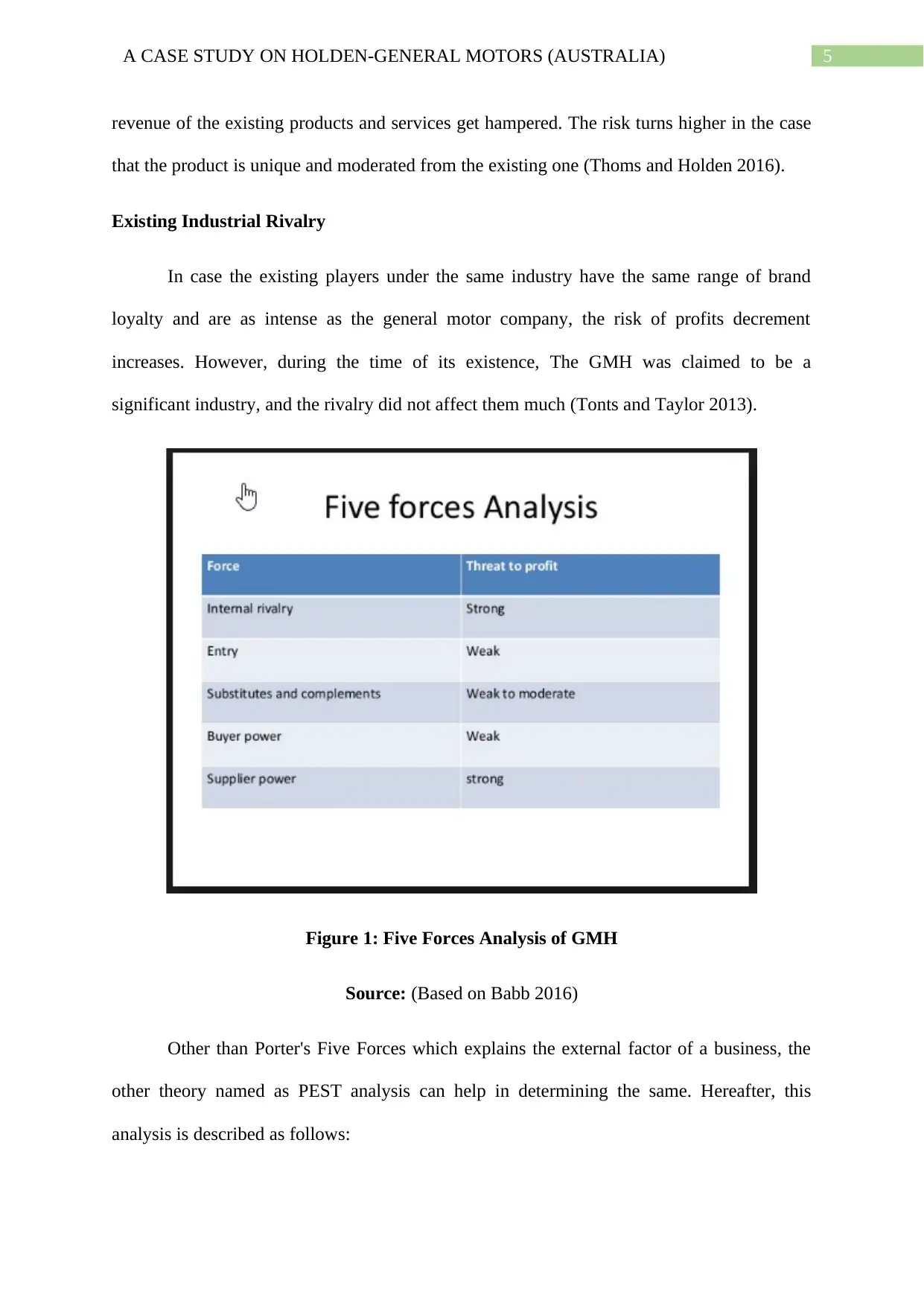
5A CASE STUDY ON HOLDEN-GENERAL MOTORS (AUSTRALIA)
revenue of the existing products and services get hampered. The risk turns higher in the case
that the product is unique and moderated from the existing one (Thoms and Holden 2016).
Existing Industrial Rivalry
In case the existing players under the same industry have the same range of brand
loyalty and are as intense as the general motor company, the risk of profits decrement
increases. However, during the time of its existence, The GMH was claimed to be a
significant industry, and the rivalry did not affect them much (Tonts and Taylor 2013).
Figure 1: Five Forces Analysis of GMH
Source: (Based on Babb 2016)
Other than Porter's Five Forces which explains the external factor of a business, the
other theory named as PEST analysis can help in determining the same. Hereafter, this
analysis is described as follows:
revenue of the existing products and services get hampered. The risk turns higher in the case
that the product is unique and moderated from the existing one (Thoms and Holden 2016).
Existing Industrial Rivalry
In case the existing players under the same industry have the same range of brand
loyalty and are as intense as the general motor company, the risk of profits decrement
increases. However, during the time of its existence, The GMH was claimed to be a
significant industry, and the rivalry did not affect them much (Tonts and Taylor 2013).
Figure 1: Five Forces Analysis of GMH
Source: (Based on Babb 2016)
Other than Porter's Five Forces which explains the external factor of a business, the
other theory named as PEST analysis can help in determining the same. Hereafter, this
analysis is described as follows:
⊘ This is a preview!⊘
Do you want full access?
Subscribe today to unlock all pages.

Trusted by 1+ million students worldwide
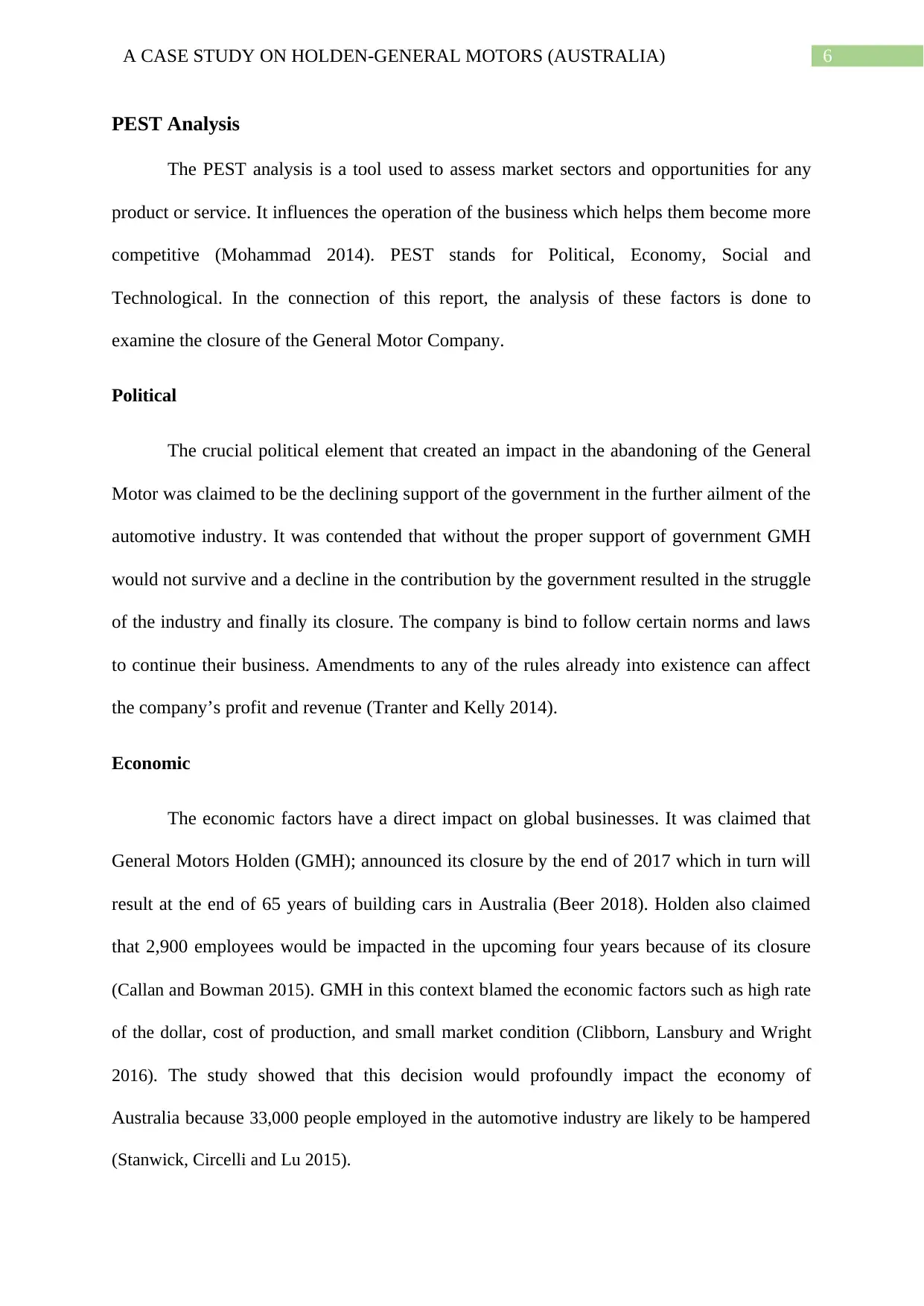
6A CASE STUDY ON HOLDEN-GENERAL MOTORS (AUSTRALIA)
PEST Analysis
The PEST analysis is a tool used to assess market sectors and opportunities for any
product or service. It influences the operation of the business which helps them become more
competitive (Mohammad 2014). PEST stands for Political, Economy, Social and
Technological. In the connection of this report, the analysis of these factors is done to
examine the closure of the General Motor Company.
Political
The crucial political element that created an impact in the abandoning of the General
Motor was claimed to be the declining support of the government in the further ailment of the
automotive industry. It was contended that without the proper support of government GMH
would not survive and a decline in the contribution by the government resulted in the struggle
of the industry and finally its closure. The company is bind to follow certain norms and laws
to continue their business. Amendments to any of the rules already into existence can affect
the company’s profit and revenue (Tranter and Kelly 2014).
Economic
The economic factors have a direct impact on global businesses. It was claimed that
General Motors Holden (GMH); announced its closure by the end of 2017 which in turn will
result at the end of 65 years of building cars in Australia (Beer 2018). Holden also claimed
that 2,900 employees would be impacted in the upcoming four years because of its closure
(Callan and Bowman 2015). GMH in this context blamed the economic factors such as high rate
of the dollar, cost of production, and small market condition (Clibborn, Lansbury and Wright
2016). The study showed that this decision would profoundly impact the economy of
Australia because 33,000 people employed in the automotive industry are likely to be hampered
(Stanwick, Circelli and Lu 2015).
PEST Analysis
The PEST analysis is a tool used to assess market sectors and opportunities for any
product or service. It influences the operation of the business which helps them become more
competitive (Mohammad 2014). PEST stands for Political, Economy, Social and
Technological. In the connection of this report, the analysis of these factors is done to
examine the closure of the General Motor Company.
Political
The crucial political element that created an impact in the abandoning of the General
Motor was claimed to be the declining support of the government in the further ailment of the
automotive industry. It was contended that without the proper support of government GMH
would not survive and a decline in the contribution by the government resulted in the struggle
of the industry and finally its closure. The company is bind to follow certain norms and laws
to continue their business. Amendments to any of the rules already into existence can affect
the company’s profit and revenue (Tranter and Kelly 2014).
Economic
The economic factors have a direct impact on global businesses. It was claimed that
General Motors Holden (GMH); announced its closure by the end of 2017 which in turn will
result at the end of 65 years of building cars in Australia (Beer 2018). Holden also claimed
that 2,900 employees would be impacted in the upcoming four years because of its closure
(Callan and Bowman 2015). GMH in this context blamed the economic factors such as high rate
of the dollar, cost of production, and small market condition (Clibborn, Lansbury and Wright
2016). The study showed that this decision would profoundly impact the economy of
Australia because 33,000 people employed in the automotive industry are likely to be hampered
(Stanwick, Circelli and Lu 2015).
Paraphrase This Document
Need a fresh take? Get an instant paraphrase of this document with our AI Paraphraser
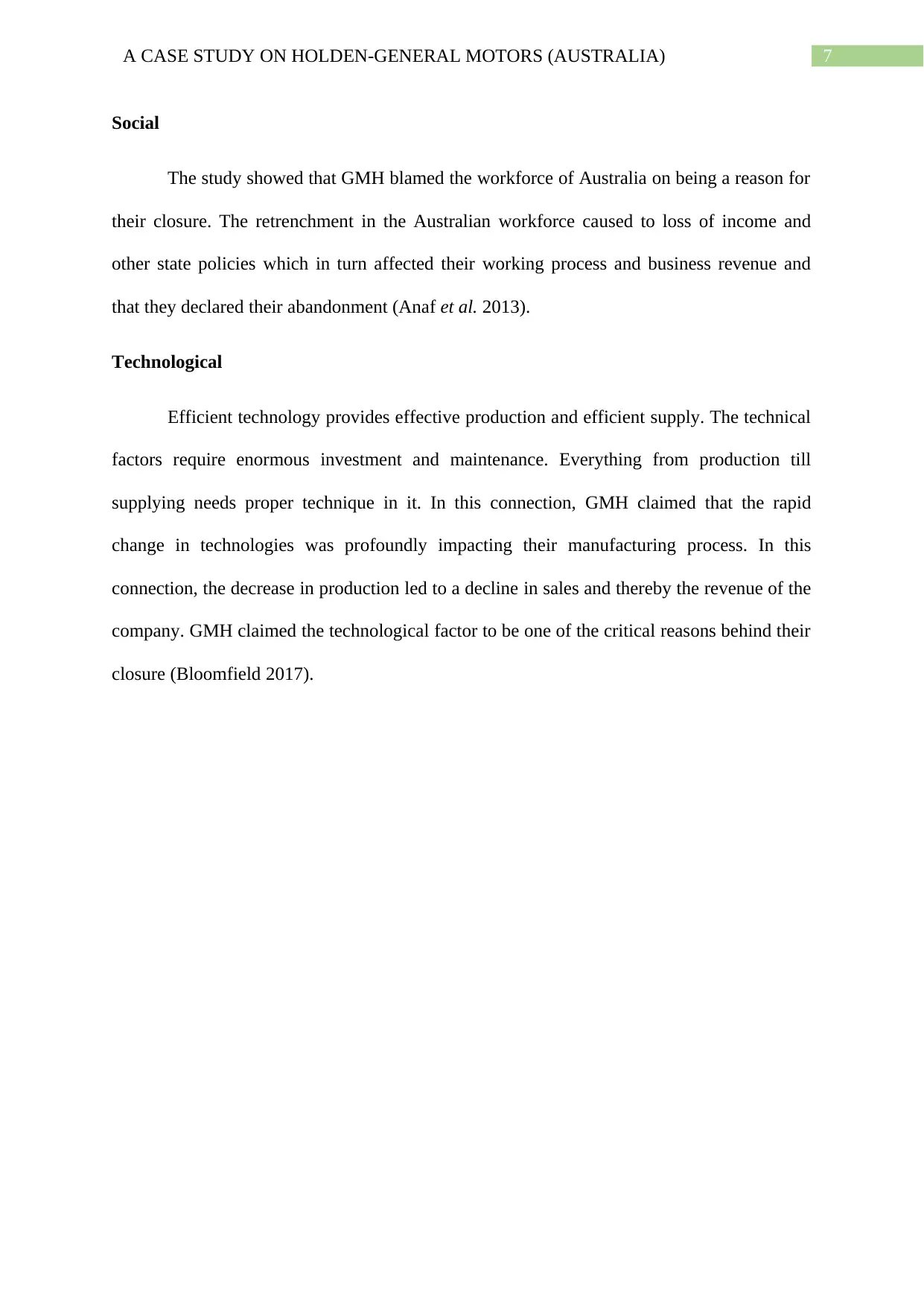
7A CASE STUDY ON HOLDEN-GENERAL MOTORS (AUSTRALIA)
Social
The study showed that GMH blamed the workforce of Australia on being a reason for
their closure. The retrenchment in the Australian workforce caused to loss of income and
other state policies which in turn affected their working process and business revenue and
that they declared their abandonment (Anaf et al. 2013).
Technological
Efficient technology provides effective production and efficient supply. The technical
factors require enormous investment and maintenance. Everything from production till
supplying needs proper technique in it. In this connection, GMH claimed that the rapid
change in technologies was profoundly impacting their manufacturing process. In this
connection, the decrease in production led to a decline in sales and thereby the revenue of the
company. GMH claimed the technological factor to be one of the critical reasons behind their
closure (Bloomfield 2017).
Social
The study showed that GMH blamed the workforce of Australia on being a reason for
their closure. The retrenchment in the Australian workforce caused to loss of income and
other state policies which in turn affected their working process and business revenue and
that they declared their abandonment (Anaf et al. 2013).
Technological
Efficient technology provides effective production and efficient supply. The technical
factors require enormous investment and maintenance. Everything from production till
supplying needs proper technique in it. In this connection, GMH claimed that the rapid
change in technologies was profoundly impacting their manufacturing process. In this
connection, the decrease in production led to a decline in sales and thereby the revenue of the
company. GMH claimed the technological factor to be one of the critical reasons behind their
closure (Bloomfield 2017).
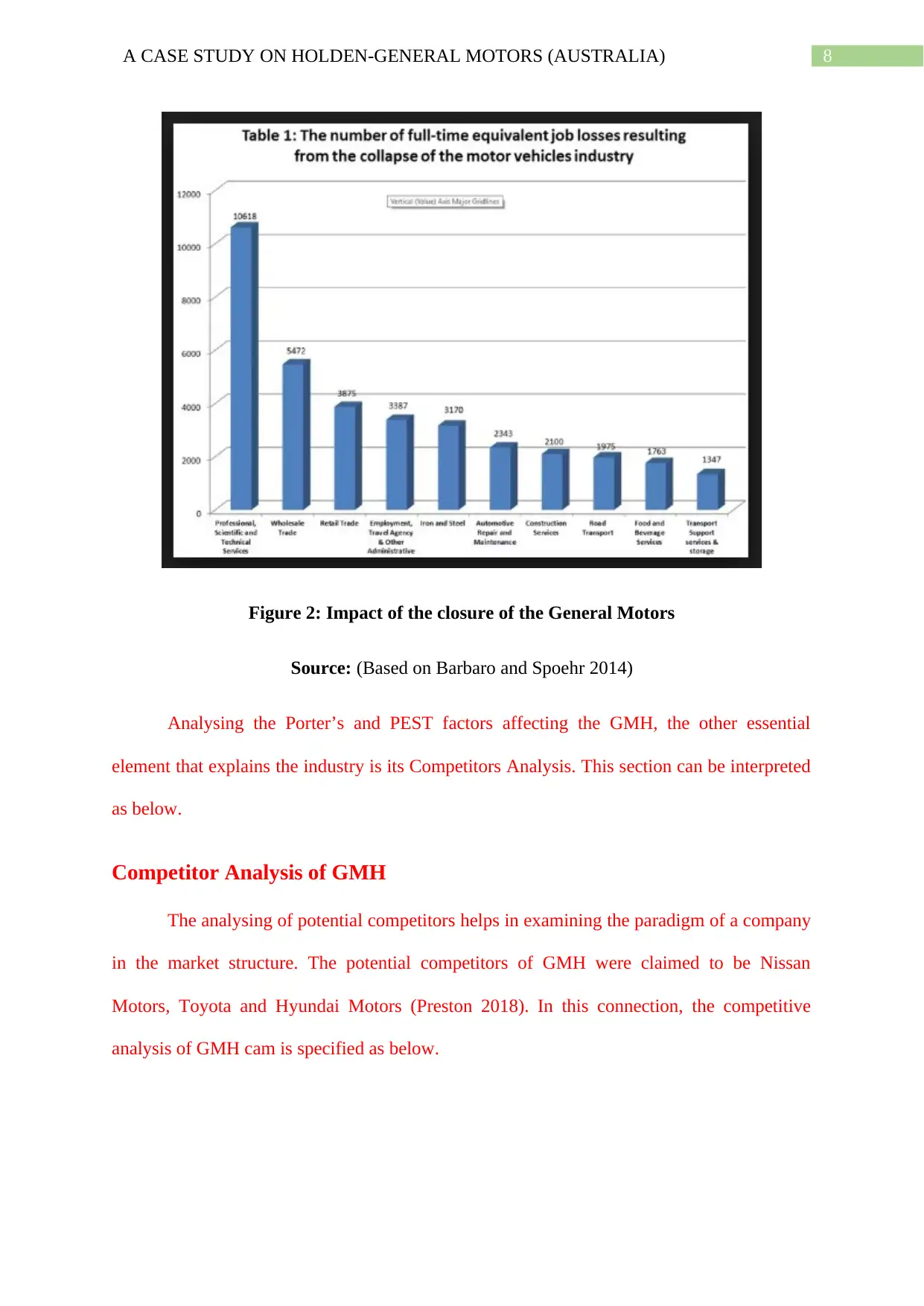
8A CASE STUDY ON HOLDEN-GENERAL MOTORS (AUSTRALIA)
Figure 2: Impact of the closure of the General Motors
Source: (Based on Barbaro and Spoehr 2014)
Analysing the Porter’s and PEST factors affecting the GMH, the other essential
element that explains the industry is its Competitors Analysis. This section can be interpreted
as below.
Competitor Analysis of GMH
The analysing of potential competitors helps in examining the paradigm of a company
in the market structure. The potential competitors of GMH were claimed to be Nissan
Motors, Toyota and Hyundai Motors (Preston 2018). In this connection, the competitive
analysis of GMH cam is specified as below.
Figure 2: Impact of the closure of the General Motors
Source: (Based on Barbaro and Spoehr 2014)
Analysing the Porter’s and PEST factors affecting the GMH, the other essential
element that explains the industry is its Competitors Analysis. This section can be interpreted
as below.
Competitor Analysis of GMH
The analysing of potential competitors helps in examining the paradigm of a company
in the market structure. The potential competitors of GMH were claimed to be Nissan
Motors, Toyota and Hyundai Motors (Preston 2018). In this connection, the competitive
analysis of GMH cam is specified as below.
⊘ This is a preview!⊘
Do you want full access?
Subscribe today to unlock all pages.

Trusted by 1+ million students worldwide
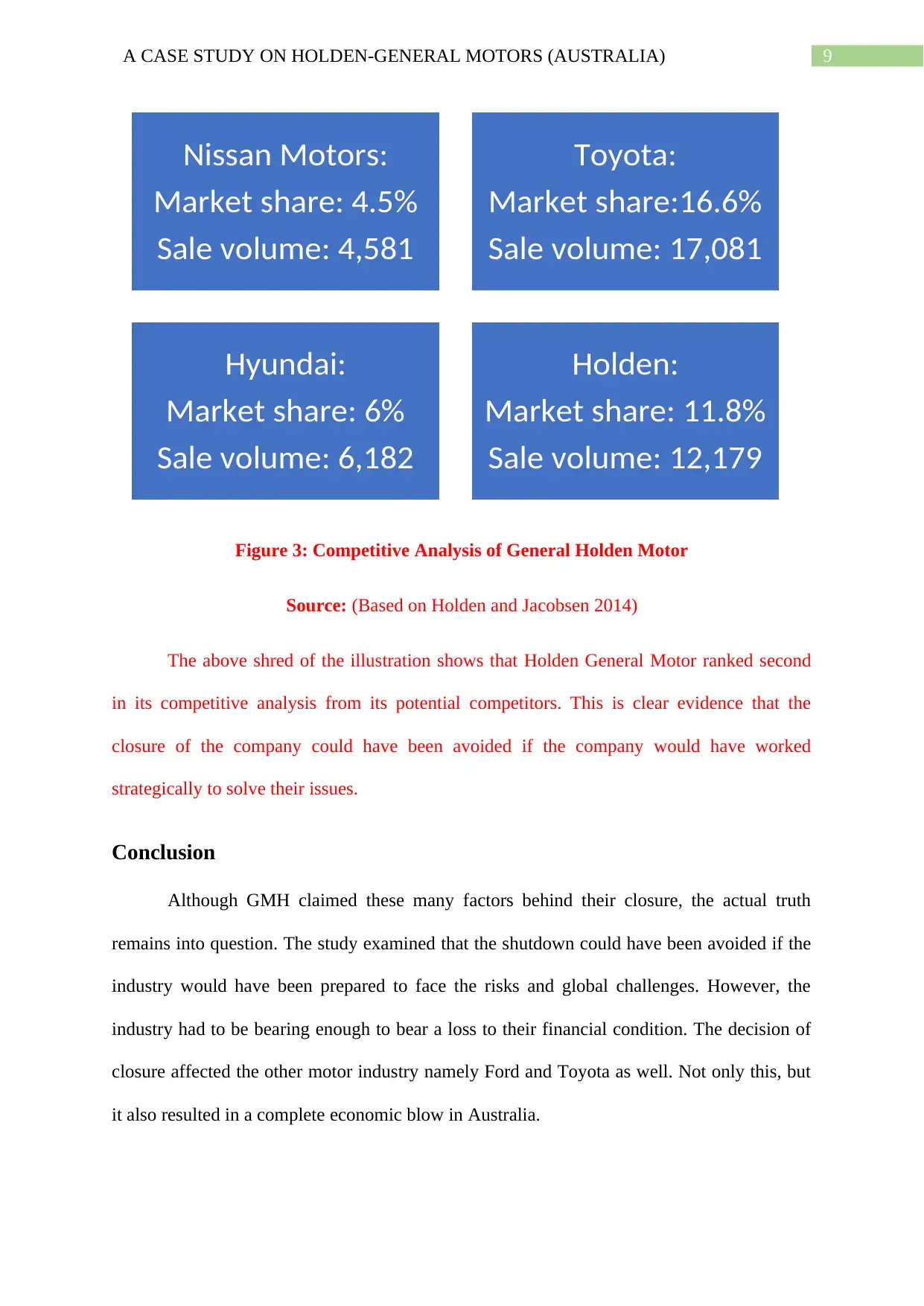
9A CASE STUDY ON HOLDEN-GENERAL MOTORS (AUSTRALIA)
Figure 3: Competitive Analysis of General Holden Motor
Source: (Based on Holden and Jacobsen 2014)
The above shred of the illustration shows that Holden General Motor ranked second
in its competitive analysis from its potential competitors. This is clear evidence that the
closure of the company could have been avoided if the company would have worked
strategically to solve their issues.
Conclusion
Although GMH claimed these many factors behind their closure, the actual truth
remains into question. The study examined that the shutdown could have been avoided if the
industry would have been prepared to face the risks and global challenges. However, the
industry had to be bearing enough to bear a loss to their financial condition. The decision of
closure affected the other motor industry namely Ford and Toyota as well. Not only this, but
it also resulted in a complete economic blow in Australia.
Nissan Motors:
Market share: 4.5%
Sale volume: 4,581
Toyota:
Market share:16.6%
Sale volume: 17,081
Hyundai:
Market share: 6%
Sale volume: 6,182
Holden:
Market share: 11.8%
Sale volume: 12,179
Figure 3: Competitive Analysis of General Holden Motor
Source: (Based on Holden and Jacobsen 2014)
The above shred of the illustration shows that Holden General Motor ranked second
in its competitive analysis from its potential competitors. This is clear evidence that the
closure of the company could have been avoided if the company would have worked
strategically to solve their issues.
Conclusion
Although GMH claimed these many factors behind their closure, the actual truth
remains into question. The study examined that the shutdown could have been avoided if the
industry would have been prepared to face the risks and global challenges. However, the
industry had to be bearing enough to bear a loss to their financial condition. The decision of
closure affected the other motor industry namely Ford and Toyota as well. Not only this, but
it also resulted in a complete economic blow in Australia.
Nissan Motors:
Market share: 4.5%
Sale volume: 4,581
Toyota:
Market share:16.6%
Sale volume: 17,081
Hyundai:
Market share: 6%
Sale volume: 6,182
Holden:
Market share: 11.8%
Sale volume: 12,179
Paraphrase This Document
Need a fresh take? Get an instant paraphrase of this document with our AI Paraphraser
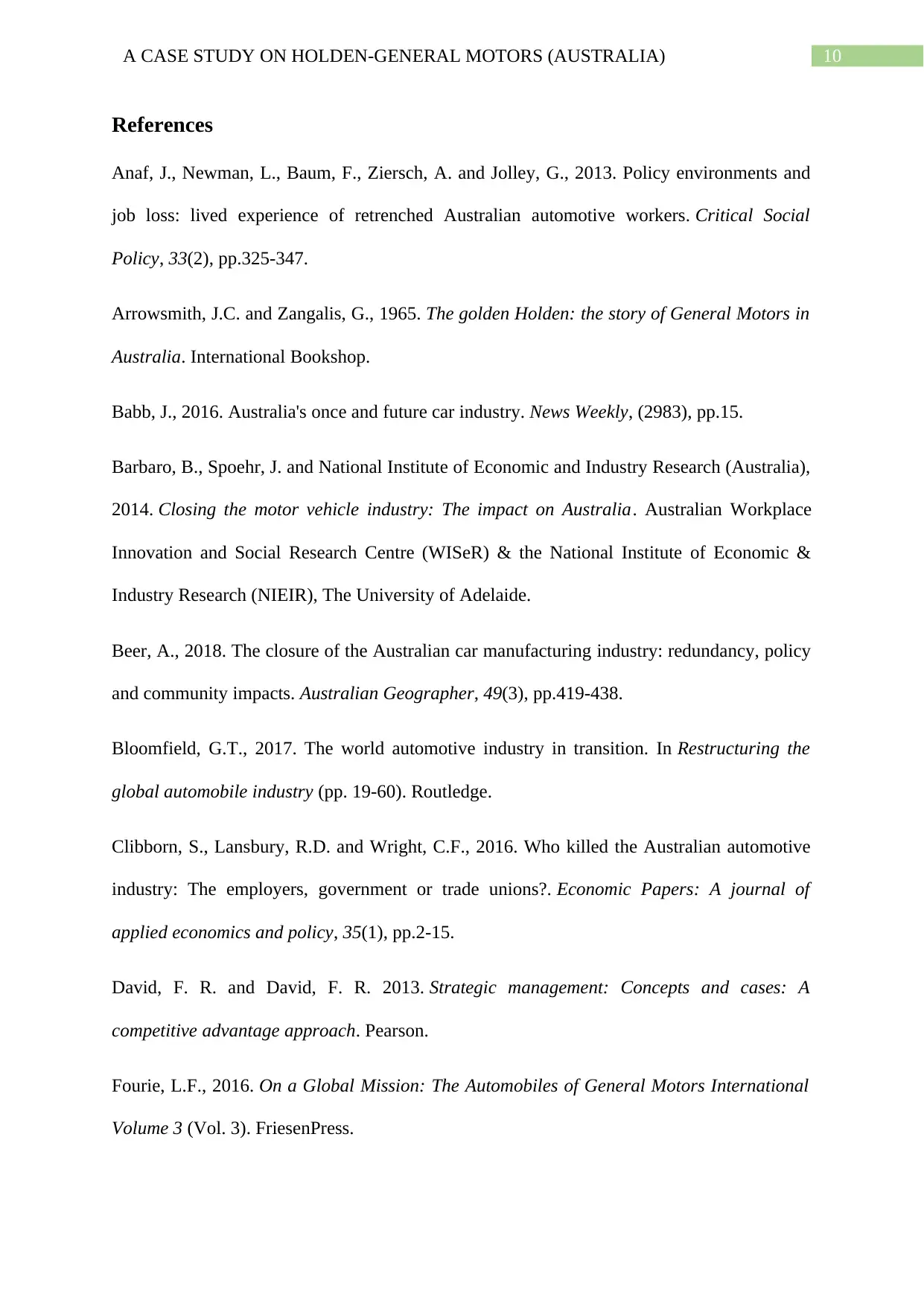
10A CASE STUDY ON HOLDEN-GENERAL MOTORS (AUSTRALIA)
References
Anaf, J., Newman, L., Baum, F., Ziersch, A. and Jolley, G., 2013. Policy environments and
job loss: lived experience of retrenched Australian automotive workers. Critical Social
Policy, 33(2), pp.325-347.
Arrowsmith, J.C. and Zangalis, G., 1965. The golden Holden: the story of General Motors in
Australia. International Bookshop.
Babb, J., 2016. Australia's once and future car industry. News Weekly, (2983), pp.15.
Barbaro, B., Spoehr, J. and National Institute of Economic and Industry Research (Australia),
2014. Closing the motor vehicle industry: The impact on Australia. Australian Workplace
Innovation and Social Research Centre (WISeR) & the National Institute of Economic &
Industry Research (NIEIR), The University of Adelaide.
Beer, A., 2018. The closure of the Australian car manufacturing industry: redundancy, policy
and community impacts. Australian Geographer, 49(3), pp.419-438.
Bloomfield, G.T., 2017. The world automotive industry in transition. In Restructuring the
global automobile industry (pp. 19-60). Routledge.
Clibborn, S., Lansbury, R.D. and Wright, C.F., 2016. Who killed the Australian automotive
industry: The employers, government or trade unions?. Economic Papers: A journal of
applied economics and policy, 35(1), pp.2-15.
David, F. R. and David, F. R. 2013. Strategic management: Concepts and cases: A
competitive advantage approach. Pearson.
Fourie, L.F., 2016. On a Global Mission: The Automobiles of General Motors International
Volume 3 (Vol. 3). FriesenPress.
References
Anaf, J., Newman, L., Baum, F., Ziersch, A. and Jolley, G., 2013. Policy environments and
job loss: lived experience of retrenched Australian automotive workers. Critical Social
Policy, 33(2), pp.325-347.
Arrowsmith, J.C. and Zangalis, G., 1965. The golden Holden: the story of General Motors in
Australia. International Bookshop.
Babb, J., 2016. Australia's once and future car industry. News Weekly, (2983), pp.15.
Barbaro, B., Spoehr, J. and National Institute of Economic and Industry Research (Australia),
2014. Closing the motor vehicle industry: The impact on Australia. Australian Workplace
Innovation and Social Research Centre (WISeR) & the National Institute of Economic &
Industry Research (NIEIR), The University of Adelaide.
Beer, A., 2018. The closure of the Australian car manufacturing industry: redundancy, policy
and community impacts. Australian Geographer, 49(3), pp.419-438.
Bloomfield, G.T., 2017. The world automotive industry in transition. In Restructuring the
global automobile industry (pp. 19-60). Routledge.
Clibborn, S., Lansbury, R.D. and Wright, C.F., 2016. Who killed the Australian automotive
industry: The employers, government or trade unions?. Economic Papers: A journal of
applied economics and policy, 35(1), pp.2-15.
David, F. R. and David, F. R. 2013. Strategic management: Concepts and cases: A
competitive advantage approach. Pearson.
Fourie, L.F., 2016. On a Global Mission: The Automobiles of General Motors International
Volume 3 (Vol. 3). FriesenPress.
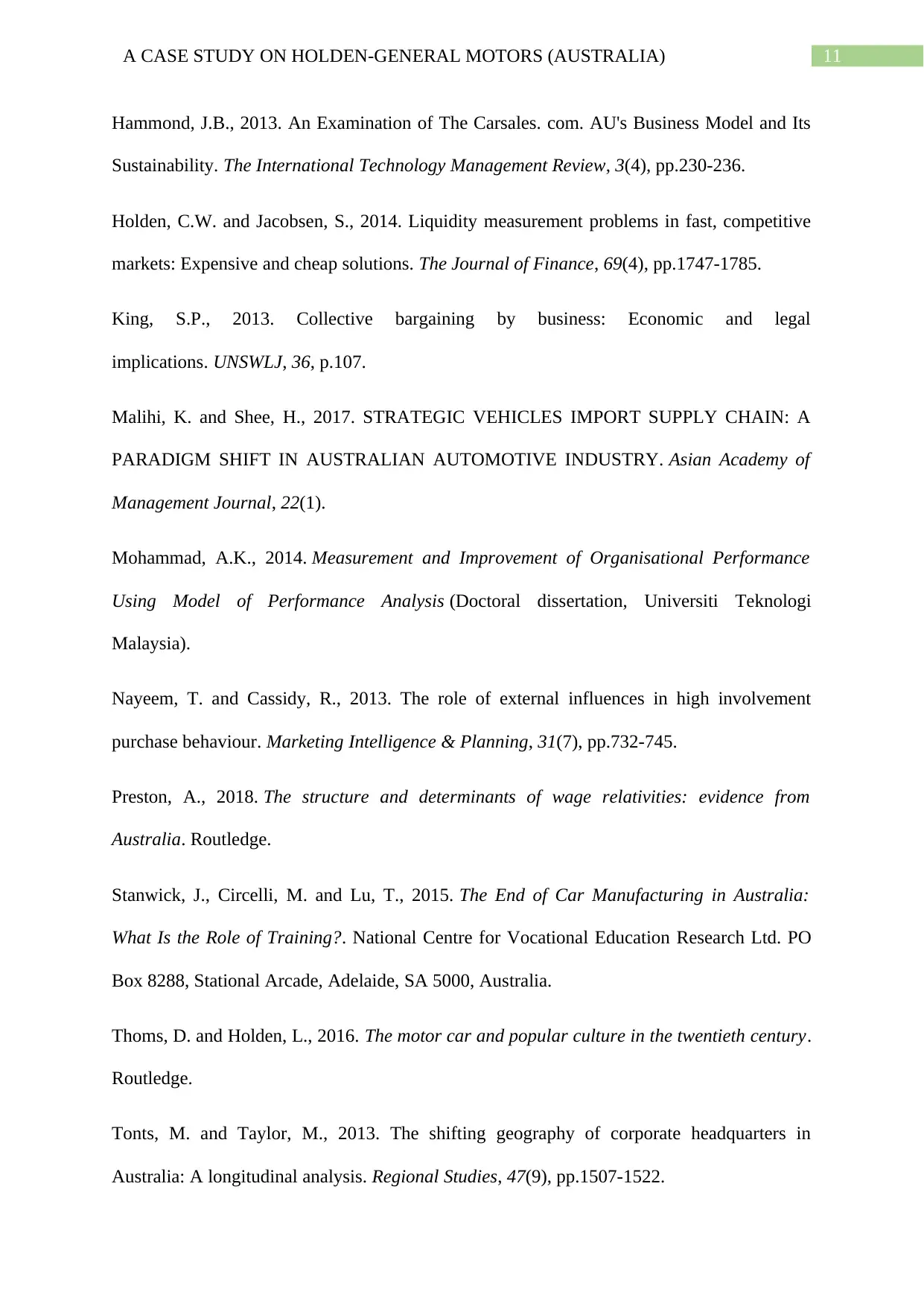
11A CASE STUDY ON HOLDEN-GENERAL MOTORS (AUSTRALIA)
Hammond, J.B., 2013. An Examination of The Carsales. com. AU's Business Model and Its
Sustainability. The International Technology Management Review, 3(4), pp.230-236.
Holden, C.W. and Jacobsen, S., 2014. Liquidity measurement problems in fast, competitive
markets: Expensive and cheap solutions. The Journal of Finance, 69(4), pp.1747-1785.
King, S.P., 2013. Collective bargaining by business: Economic and legal
implications. UNSWLJ, 36, p.107.
Malihi, K. and Shee, H., 2017. STRATEGIC VEHICLES IMPORT SUPPLY CHAIN: A
PARADIGM SHIFT IN AUSTRALIAN AUTOMOTIVE INDUSTRY. Asian Academy of
Management Journal, 22(1).
Mohammad, A.K., 2014. Measurement and Improvement of Organisational Performance
Using Model of Performance Analysis (Doctoral dissertation, Universiti Teknologi
Malaysia).
Nayeem, T. and Cassidy, R., 2013. The role of external influences in high involvement
purchase behaviour. Marketing Intelligence & Planning, 31(7), pp.732-745.
Preston, A., 2018. The structure and determinants of wage relativities: evidence from
Australia. Routledge.
Stanwick, J., Circelli, M. and Lu, T., 2015. The End of Car Manufacturing in Australia:
What Is the Role of Training?. National Centre for Vocational Education Research Ltd. PO
Box 8288, Stational Arcade, Adelaide, SA 5000, Australia.
Thoms, D. and Holden, L., 2016. The motor car and popular culture in the twentieth century.
Routledge.
Tonts, M. and Taylor, M., 2013. The shifting geography of corporate headquarters in
Australia: A longitudinal analysis. Regional Studies, 47(9), pp.1507-1522.
Hammond, J.B., 2013. An Examination of The Carsales. com. AU's Business Model and Its
Sustainability. The International Technology Management Review, 3(4), pp.230-236.
Holden, C.W. and Jacobsen, S., 2014. Liquidity measurement problems in fast, competitive
markets: Expensive and cheap solutions. The Journal of Finance, 69(4), pp.1747-1785.
King, S.P., 2013. Collective bargaining by business: Economic and legal
implications. UNSWLJ, 36, p.107.
Malihi, K. and Shee, H., 2017. STRATEGIC VEHICLES IMPORT SUPPLY CHAIN: A
PARADIGM SHIFT IN AUSTRALIAN AUTOMOTIVE INDUSTRY. Asian Academy of
Management Journal, 22(1).
Mohammad, A.K., 2014. Measurement and Improvement of Organisational Performance
Using Model of Performance Analysis (Doctoral dissertation, Universiti Teknologi
Malaysia).
Nayeem, T. and Cassidy, R., 2013. The role of external influences in high involvement
purchase behaviour. Marketing Intelligence & Planning, 31(7), pp.732-745.
Preston, A., 2018. The structure and determinants of wage relativities: evidence from
Australia. Routledge.
Stanwick, J., Circelli, M. and Lu, T., 2015. The End of Car Manufacturing in Australia:
What Is the Role of Training?. National Centre for Vocational Education Research Ltd. PO
Box 8288, Stational Arcade, Adelaide, SA 5000, Australia.
Thoms, D. and Holden, L., 2016. The motor car and popular culture in the twentieth century.
Routledge.
Tonts, M. and Taylor, M., 2013. The shifting geography of corporate headquarters in
Australia: A longitudinal analysis. Regional Studies, 47(9), pp.1507-1522.
⊘ This is a preview!⊘
Do you want full access?
Subscribe today to unlock all pages.

Trusted by 1+ million students worldwide
1 out of 13
Related Documents
Your All-in-One AI-Powered Toolkit for Academic Success.
+13062052269
info@desklib.com
Available 24*7 on WhatsApp / Email
![[object Object]](/_next/static/media/star-bottom.7253800d.svg)
Unlock your academic potential
Copyright © 2020–2025 A2Z Services. All Rights Reserved. Developed and managed by ZUCOL.





